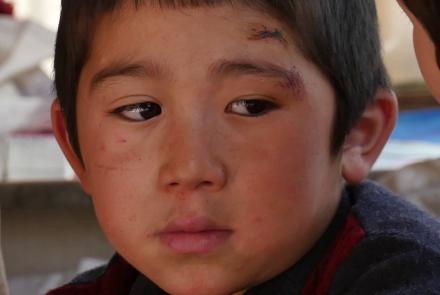Over 630 children were killed and wounded in Afghanistan in the first six months of 2020 due to war and violence, the Afghan Independent Human Rights Commission (AIHRC) said on Tuesday. Of that figure, 225 children were killed and 405 others were wounded.
The rights body said that the main cause of the deaths and injuries was an escalation of violence in the residential areas.
“630 children in Afghanistan were among the casualties—225 children killed and 405 more wounded. Of course, the figure will be much higher than this. According to the international conventions on human rights, those people who are not involved in the war, killing them is a war crime,” said Zabihullah Farhan, a spokesman for the AIHRC.
Rajab, 8, is an Afghan child who lost his entire family in the war.
Rajab lost his mother, father, two brothers, and a sister in a roadside mine blast in Maidan Wardak province.
Rajab’s relatives have said that he is now suffering from psychological issues due to the tragedy.
“Two of my grandchildren, my son and his pregnant wife were there,” said Najab, grandfather of Rajab.
“Afghanistan is seen as a country where there is no value for children and instead children are attacked,” said Rahmatullah, Rajab’s uncle.
Last month, The International Committee of the Red Cross (ICRC) said that Afghanistan remains the deadliest country for civilians, with Afghan women and children making up half of the fatalities.
Back in October, The UN mission to Afghanistan (UNAMA) in a report said that, overall, the civilian casualty figure for the first nine months of 2020 dropped by around 30 percent compared to the same period in 2019, but while the number of civilian casualties is the lowest in the first nine months of any year since 2012, “the harm done to civilians remains inordinate and shocking.”
UNAMA documented that Anti-Government Elements (AGEs) remain responsible for the majority of civilian casualties (58 percent). Compared to the same period in 2019, the amount of civilian deaths attributed to AGEs remained at similar levels, although there was a decrease of 34 percent in the total number of civilian casualties – killed and injured – attributed to AGEs, said the report.
The report said that the number of civilians killed attributed to the Taliban increased by six percent in the first nine months of 2020, adding that the overall number of civilian casualties – killed and injured – attributed to the Taliban dropped by 32 percent, mainly due to a reduction in the number of civilians injured by suicide attacks and ground engagements, though this was partially offset by an increased number of civilian casualties from targeted killings and illegal, indiscriminate pressure-plate improvised explosives devices (IEDs).
Attacks causing civilian casualties carried out by undetermined age increased. There were more incidents, especially in relation to the use of IEDs and targeted killings, in which UNAMA could not determine which anti-government group was responsible. This also corresponds with a decrease in the number of incidents for which the Taliban or Daesh claimed responsibility.

